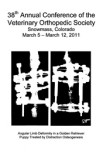OBJECTIVE: To compare the biomechanical properties of locking compression plate (LCP) and a limited contact dynamic compression plate combined with an intramedullary rod (LC-DCP-R) in a cadaveric, canine, femoral fracture-gap model.
STUDY DESIGN: In vitro biomechanical study; nonrandomized, complete block (dog).
SAMPLE POPULATION: Paired cadaveric canine femora (n = 10 dogs).
METHODS: Paired femurs with a mid-diaphyseal 20 mm gap were stabilized with either LCP or LC-DCP-R. Nondestructive testing up to 60% of body weight (BW) was followed by a continuous destructive test. Comparative structural properties, 3-dimensional (3D) interfragmentary motion, and plate linear strain were evaluated. Paired comparisons were made between LCP and LC-DCP-R.
RESULTS: Stiffness after nondestructive testing was significantly lower for LCP with a mean (95% confidence interval [CI]) of 61 N/mm (46-76) versus 89 N/mm (67-110) for LC-DCP-R (P = .0072). Ultimate load to failure was significantly lower for LCP with a median (interquartile range [IQR]) of 270 N (247-286) versus 371.5 (353-385) for LC-DCP-R (P = .002). Axial motion at 60% BW was significantly higher for LCP with a median (IQR) of 1.01 mm (0.71-1.26) versus 0.36 mm (0.20-0.49) for LC-DCP-R (P = .002). Shear motion was significantly higher for LCP with a median (IQR) of 1.18 (0.78-1.58) versus 0.72 mm (0.45-1.00) for LC-DCP-R (P = .018). Strain was significantly higher for mid-LCP surface with a mean (95%CI) at 60% BW of 979 μdef (579-1378) versus 583 μdef (365-801) at mid-LC-DCP-R surface (P = .0153). The elastic limit strain of the plates was not different and was reached at a mean (95%CI) load of 241 N (190-292) for LCP versus 290 N (245-336) for LC-DCP-R (P = .12).
CONCLUSION: The LC-DCP-R showed higher stiffness and resistance to failure, lower interfragmentary motion, and lower plate strain and stress compared to LCP.
Biomechanical comparison of locking compression plate and limited contact dynamic compression plate combined with an intramedullary rod in a canine femoral fracture-gap model
Journal
Matres-Lorenzo L, Diop A, Maurel N, Boucton MC, Bernard F, Bernardé A. Vet Surg. 2016 Apr; 45 (3): 319-26.









